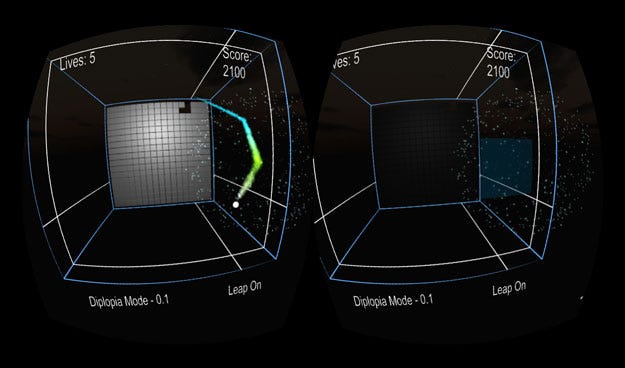Virtual Reality Therapy for Visually Impaired Boasts Real Results
August 25, 2014
An interactive virtual reality game could help improve visual impairments for patients suffering from conditions such as strabismus (crossed eyes), diplopia (double vision), and amblyopia (lazy eye). The game developed by Lansing, MI-based programmer James Blaha could especially be useful in treating strabismus.
Blaha, who grew up suffering from strabismus, set out to create a virtual reality game that could help the brain work with the suppressed eye in conjunction with the healthy eye in an effort to strengthen the eyes to work together.
The game is called Diplopia, and is built for the Oculus Rift, a head-mounted virtual reality display system. The game is specifically designed to only show some of the elements of the video game to each eye, forcing the player to use information from both eyes to complete the level.
|
Here 'Dilpopia Mode' is enabled, the game shows the ball and bright bricks to the left eye while showing the paddle and dark bricks to the right. This forces the player's brain to utilize both eyes to win. |
The game has raised more than $20,000 on Kickstarter--ten times the original funding goal.
So far Blaha's game has been used in treatments and has proven to be more than six times more effective than typical treatment. The game offers a fun, interactive alternative treatment that can engage people of all ages.
The game also includes tests for color blindness as well as visual acuity. Blaha also designed the game to operate in three dimensions, training the eyes in an environment more apt to real life. There will also be several testing modes to measure suppression, and the angle and type of offset between the eyes. Blaha hopes that such measurements will help determine optimal techniques for treatment.
Strabismus, more commonly known as "crossed eyes," is a condition in which the two eyes do not line up in the same direction, resulting in the failure to focus on one object at the same time. This condition frequently leads to diplopia and/or amblyopia, which further distort the images received by the brain. Since the brain receives two separate conflicting images from both eyes, it often learns to disregard the weaker of the two eyes.
Doctor's long believed that once a person's brain had learned to suppress one of their eyes, they could only train their brain to unlearn the suppression before a "critical age" thought to be between eight and 12 years old. However, recent studies have shown that certain kinds of therapies, including video games, can continue to treat these conditions well beyond adolescence.
Recent data indicates that over 20 million people in the US alone suffer from amblyopia, which can lead to a loss in depth perception and 3-D vision. Although Blaha continues to collect data, he hopes to continue to develop a more polished product that will take vision therapy to all new heights.
There is been a growing interest of late in using virtual reality technology for medical applications. For instance, Spanish researchers have announced that virtual reality headsets can help patients suffering from preoperative stress.
Refresh your medical device industry knowledge at MEDevice San Diego, September 10-11, 2014. |
Kristopher Sturgis is a contributor to Qmed and MPMN.
Like what you're reading? Subscribe to our daily e-newsletter.
About the Author(s)
You May Also Like


.png?width=300&auto=webp&quality=80&disable=upscale)
